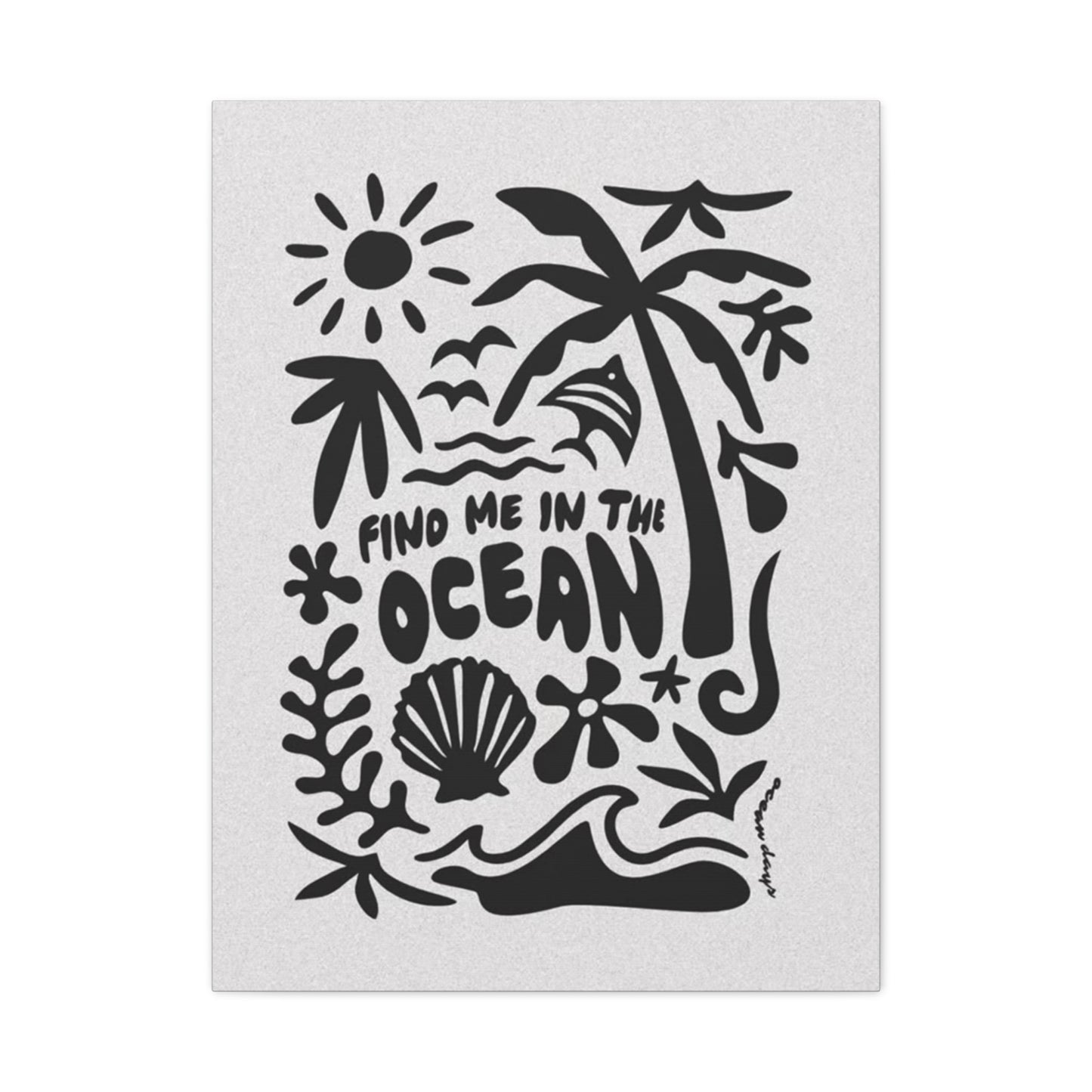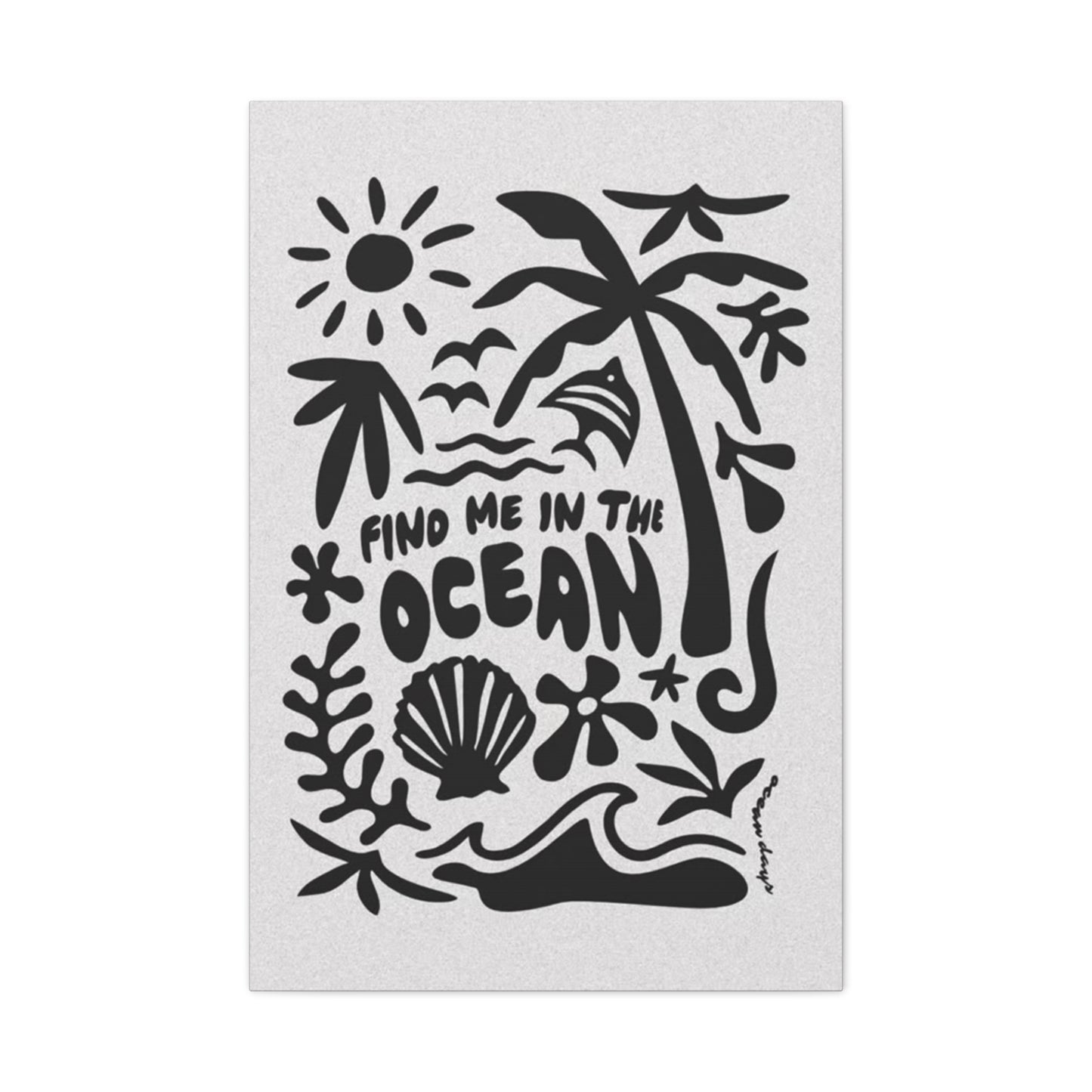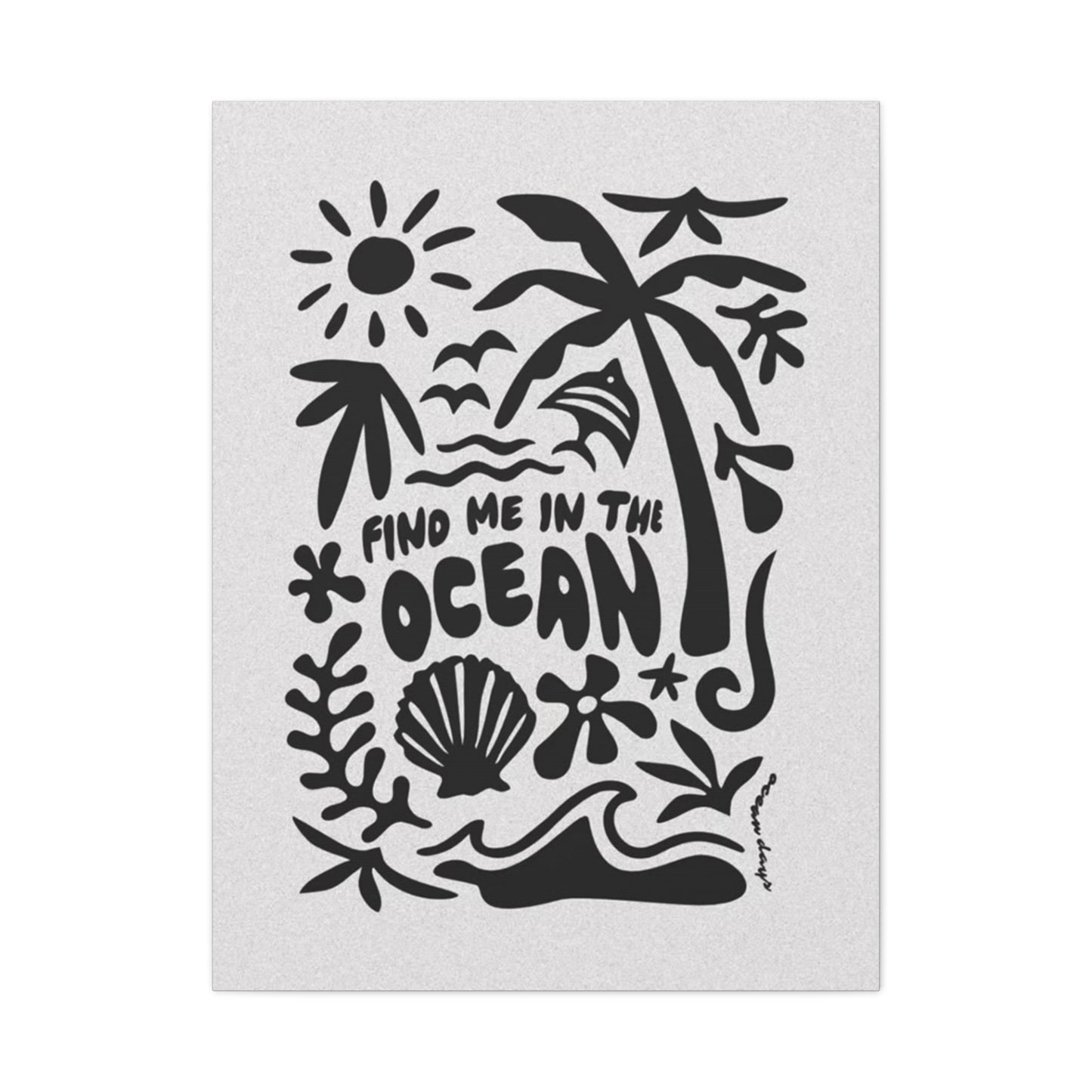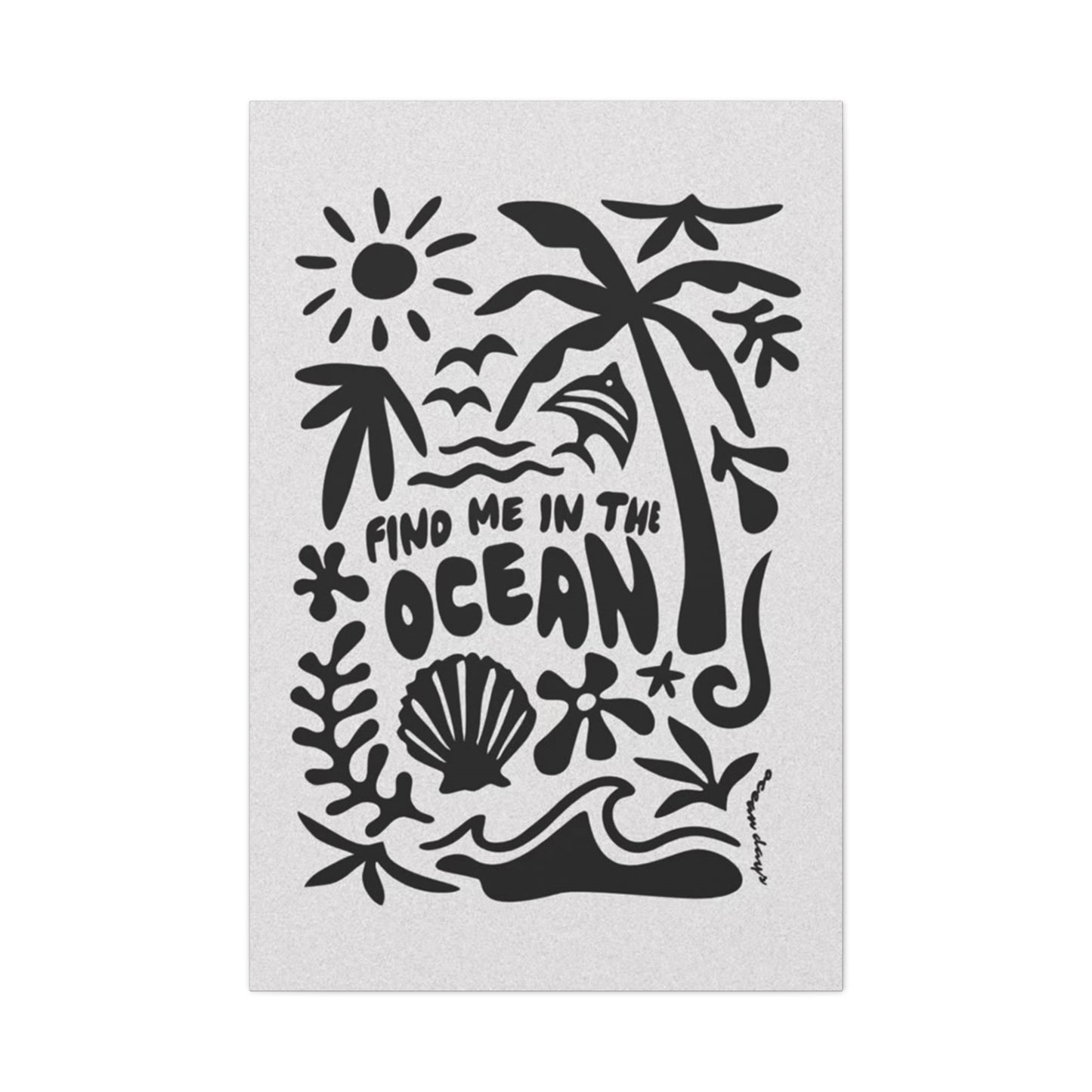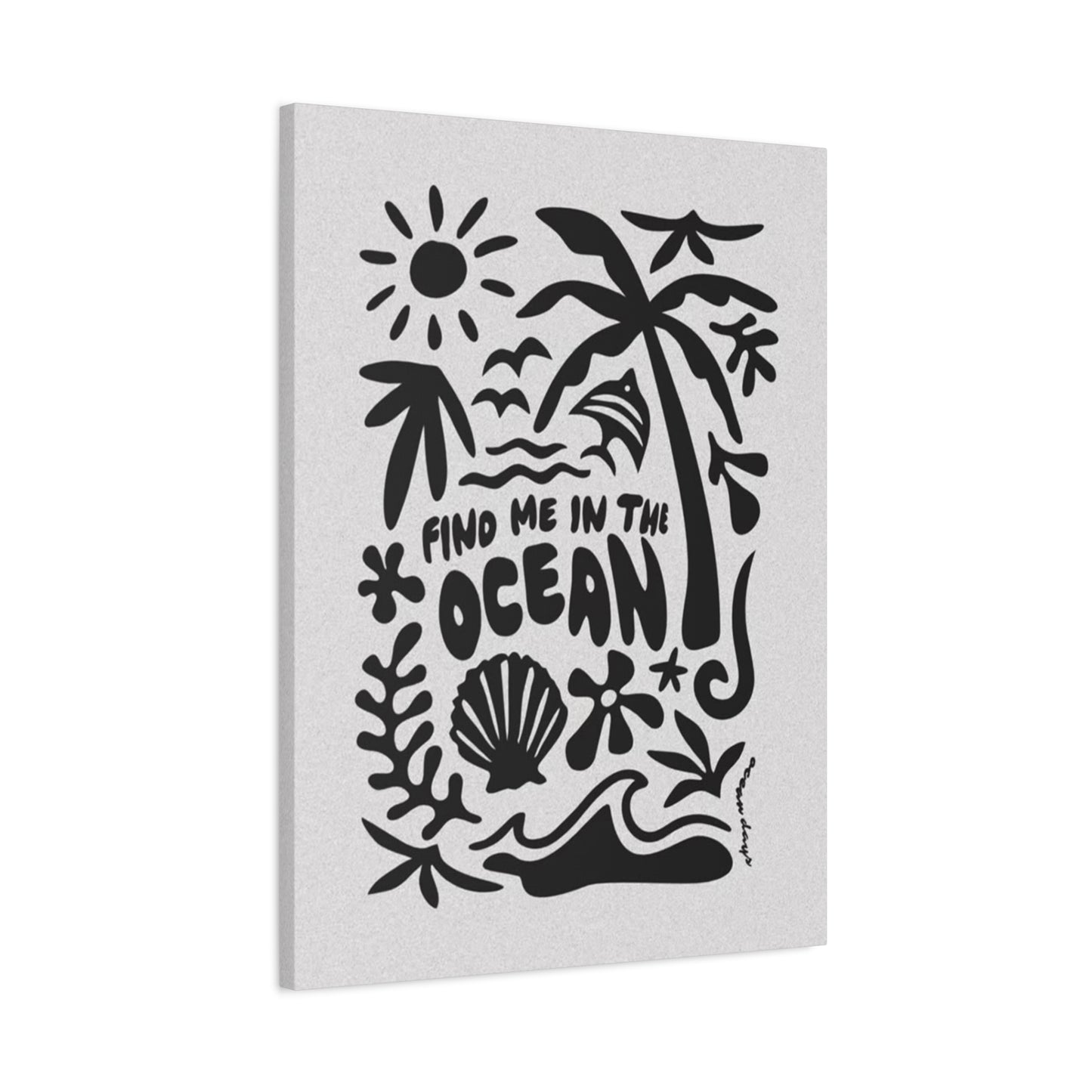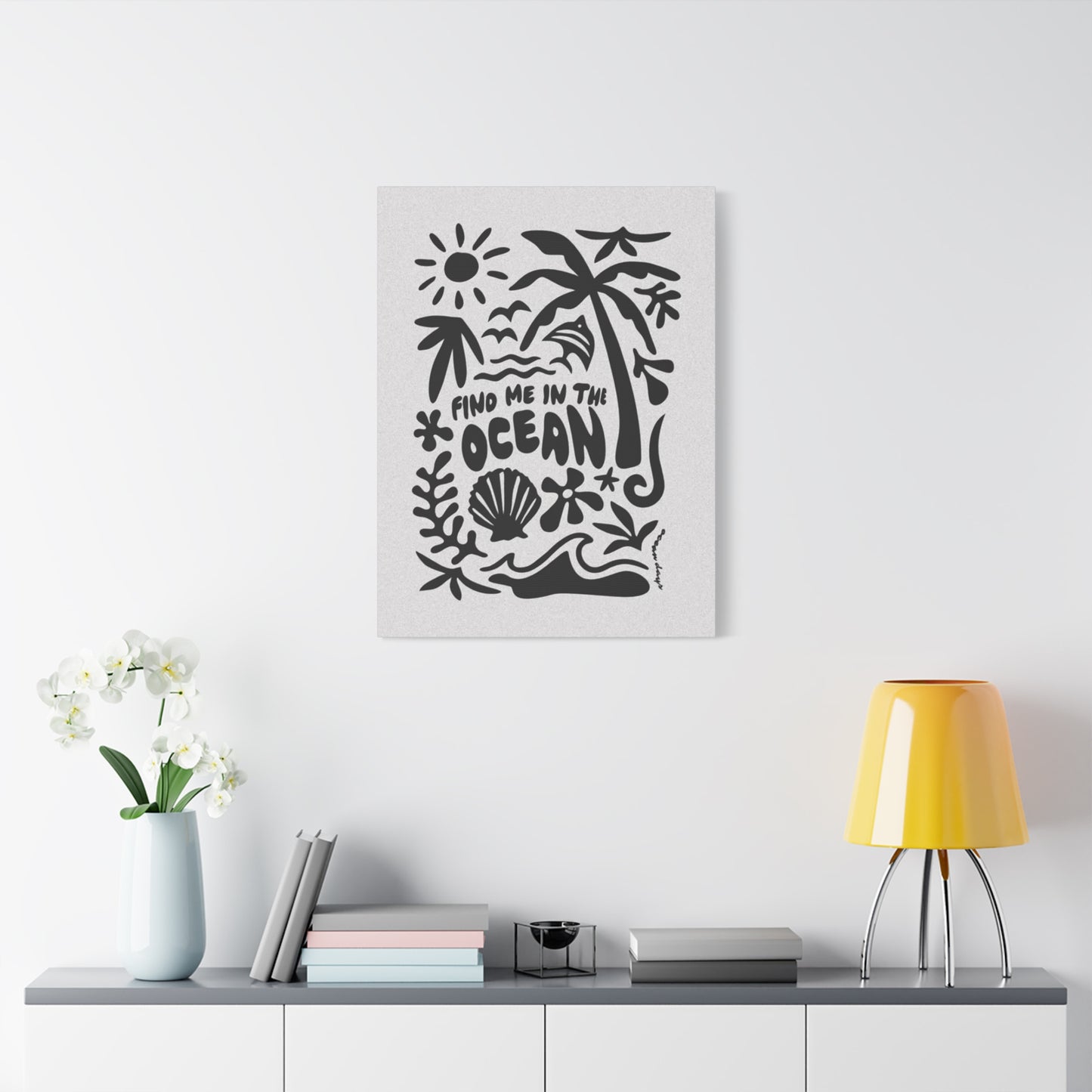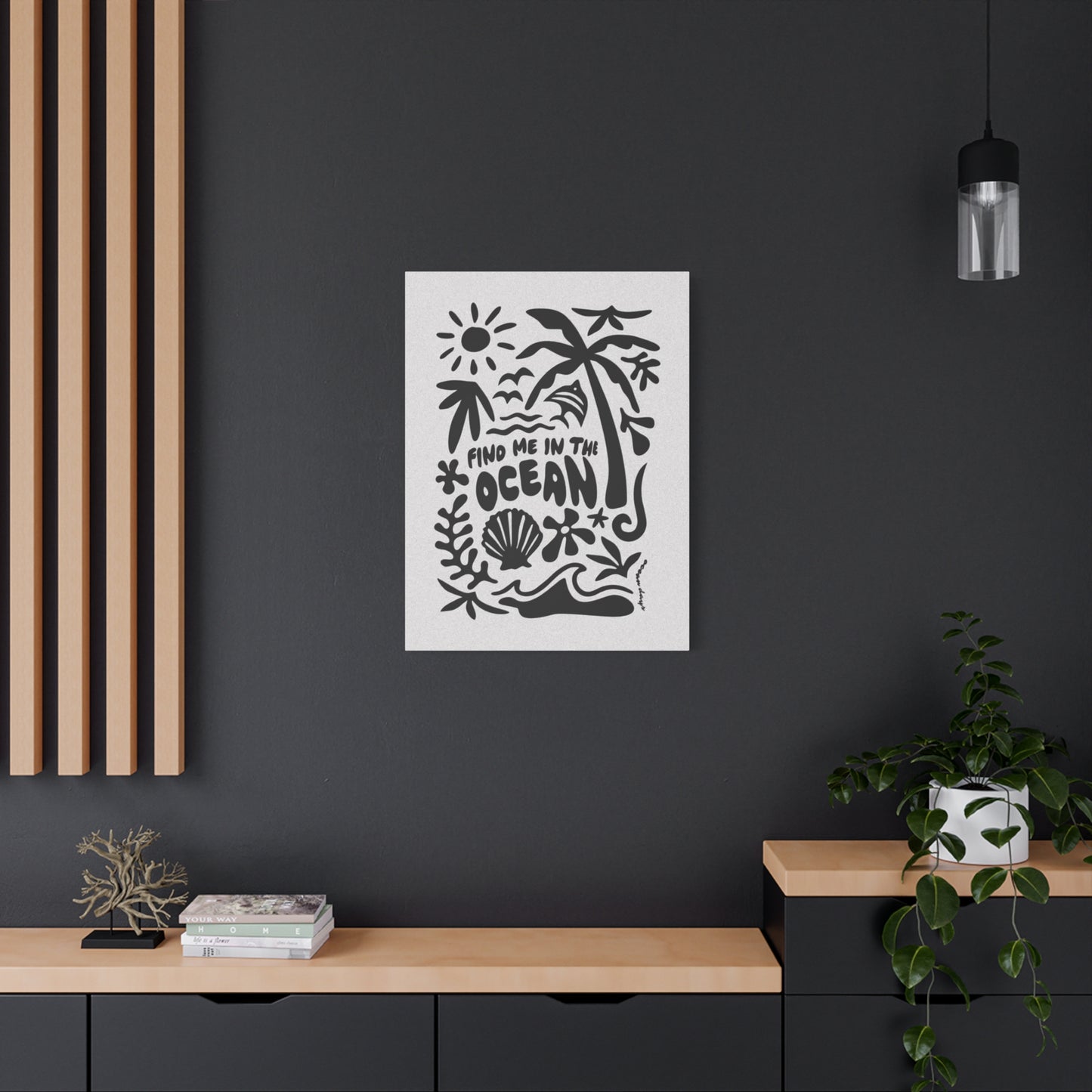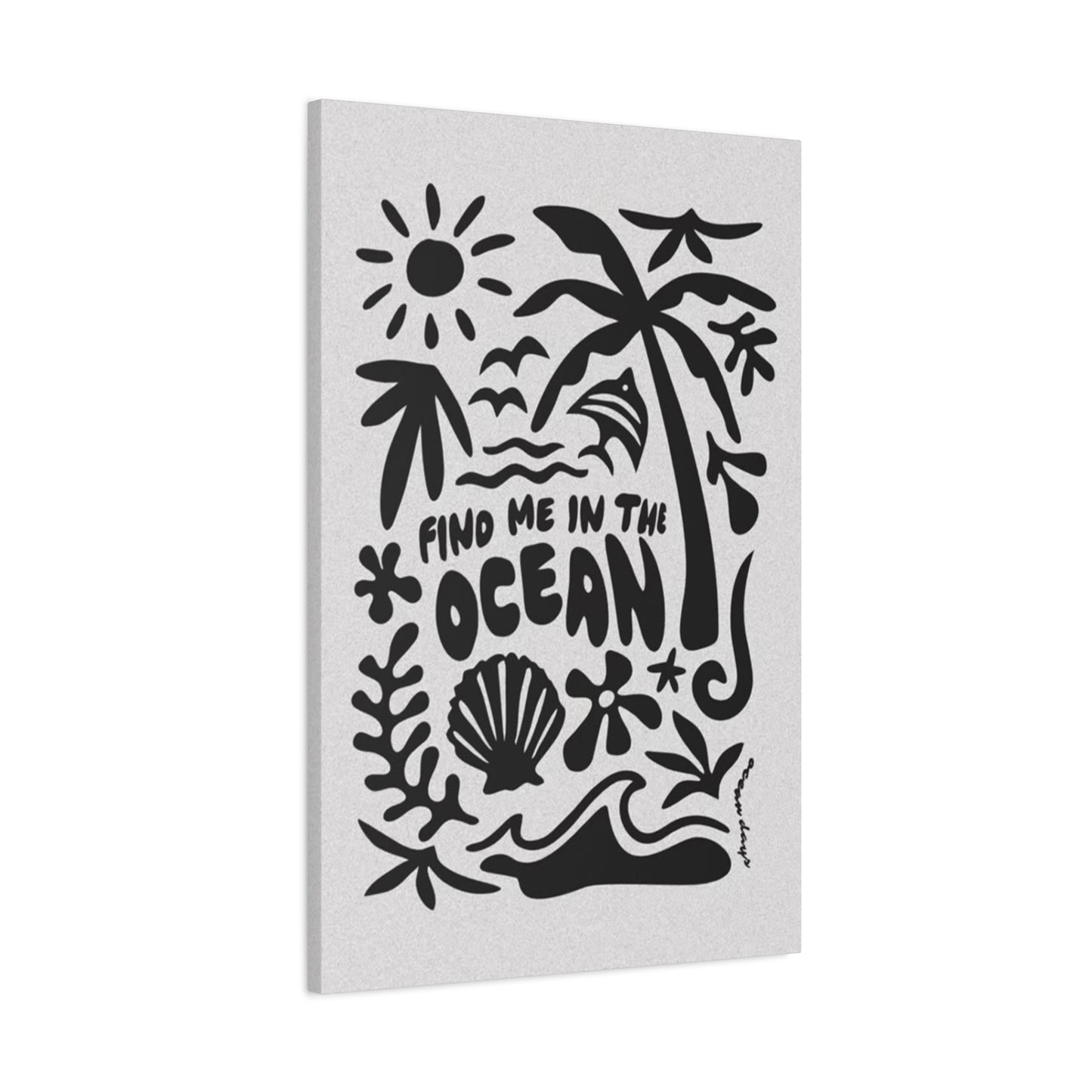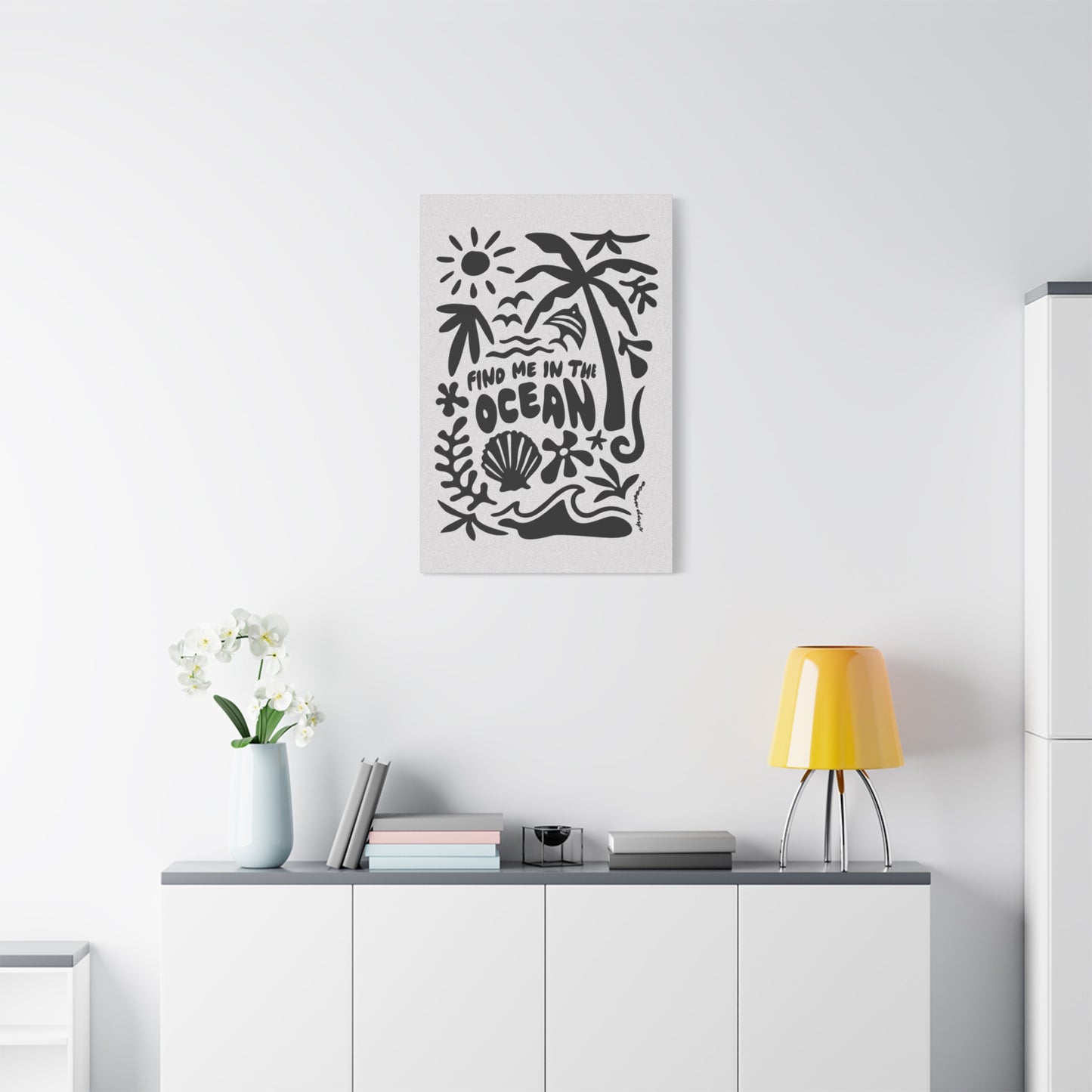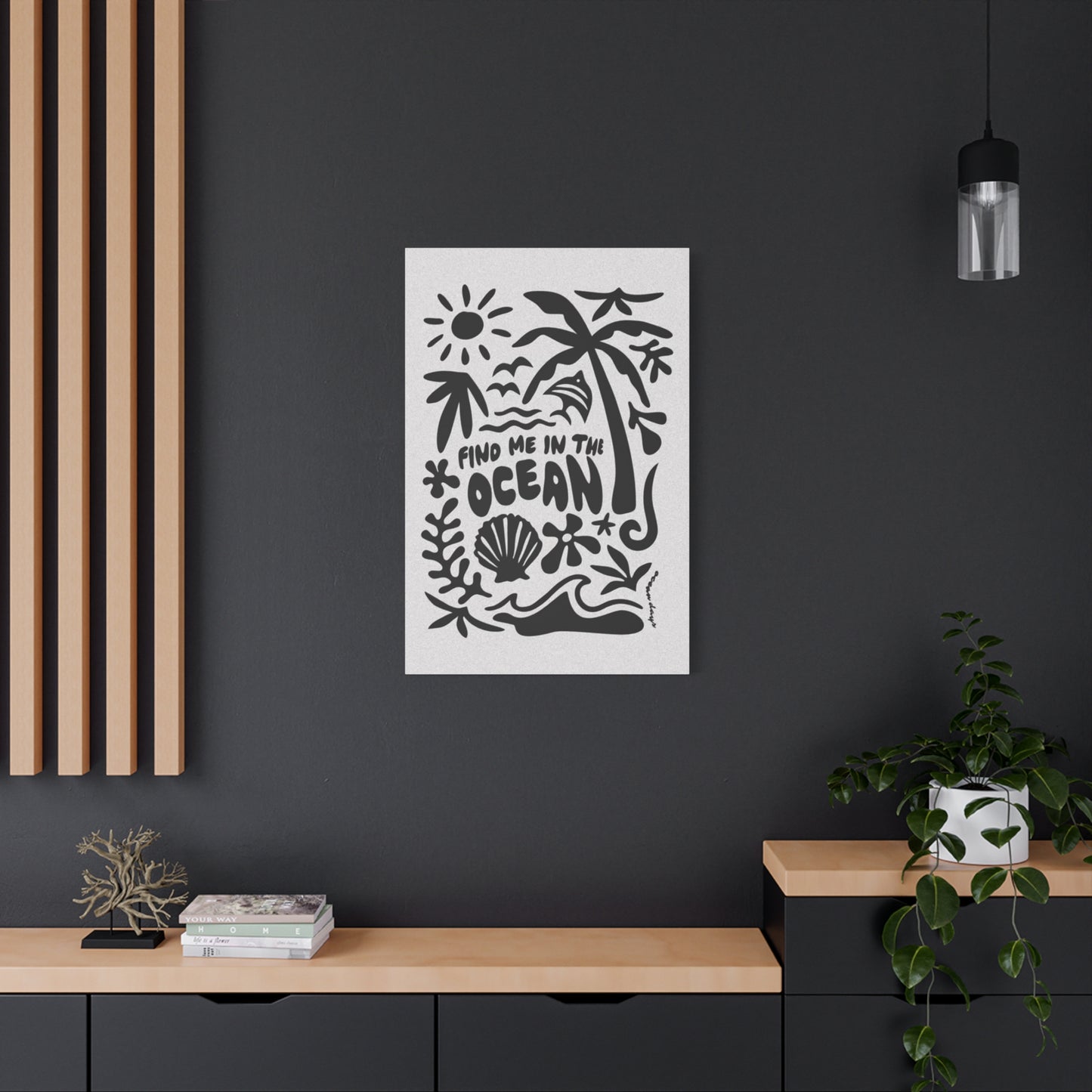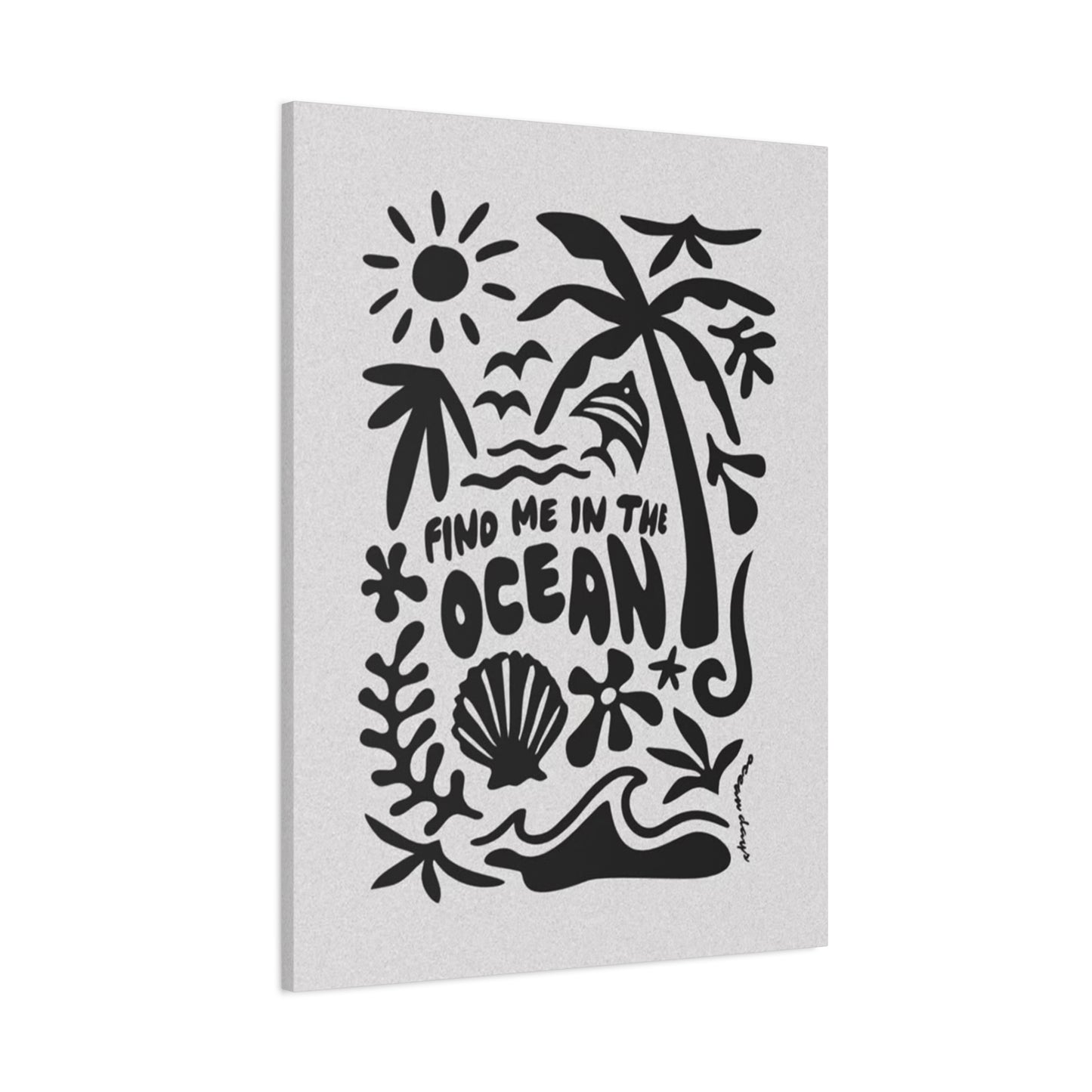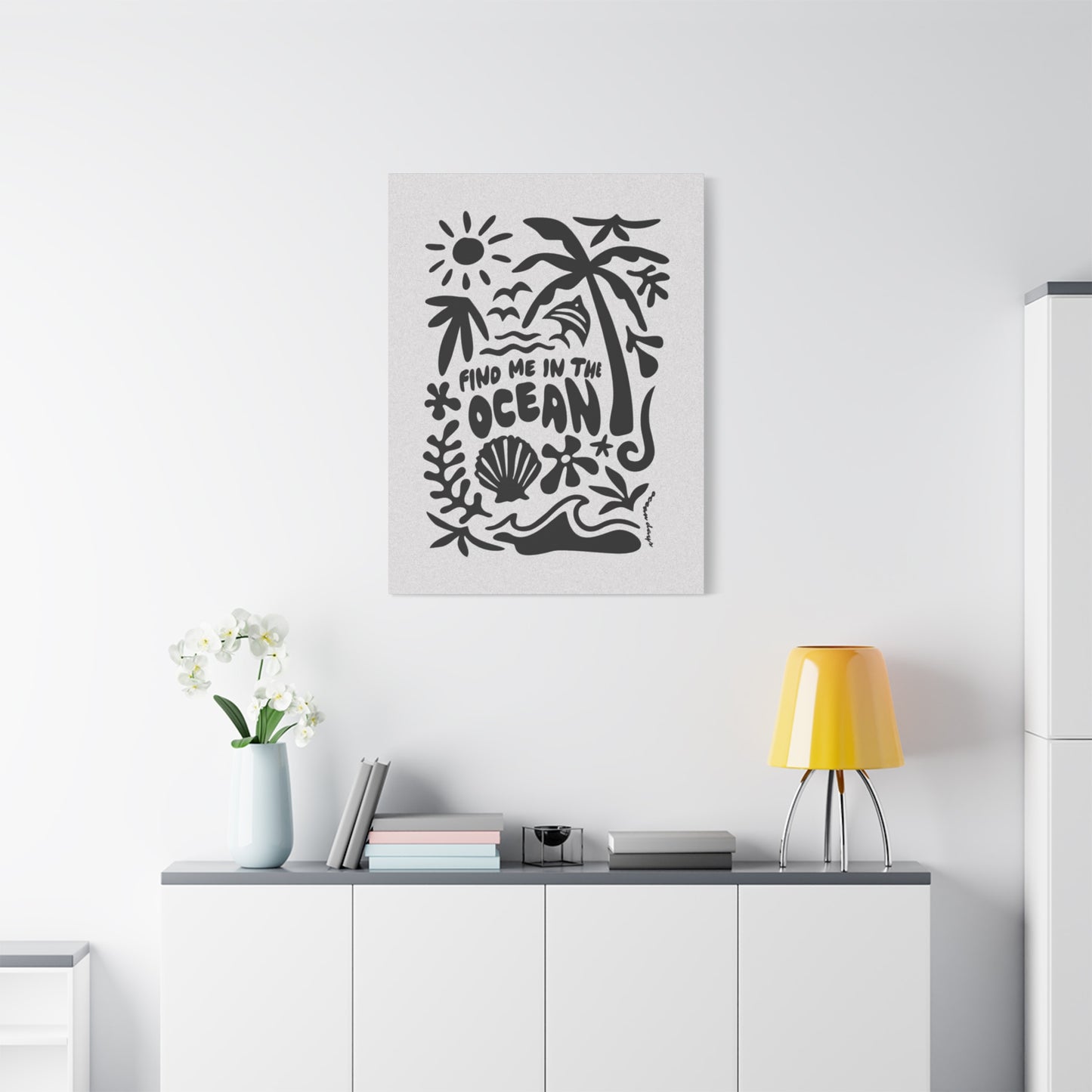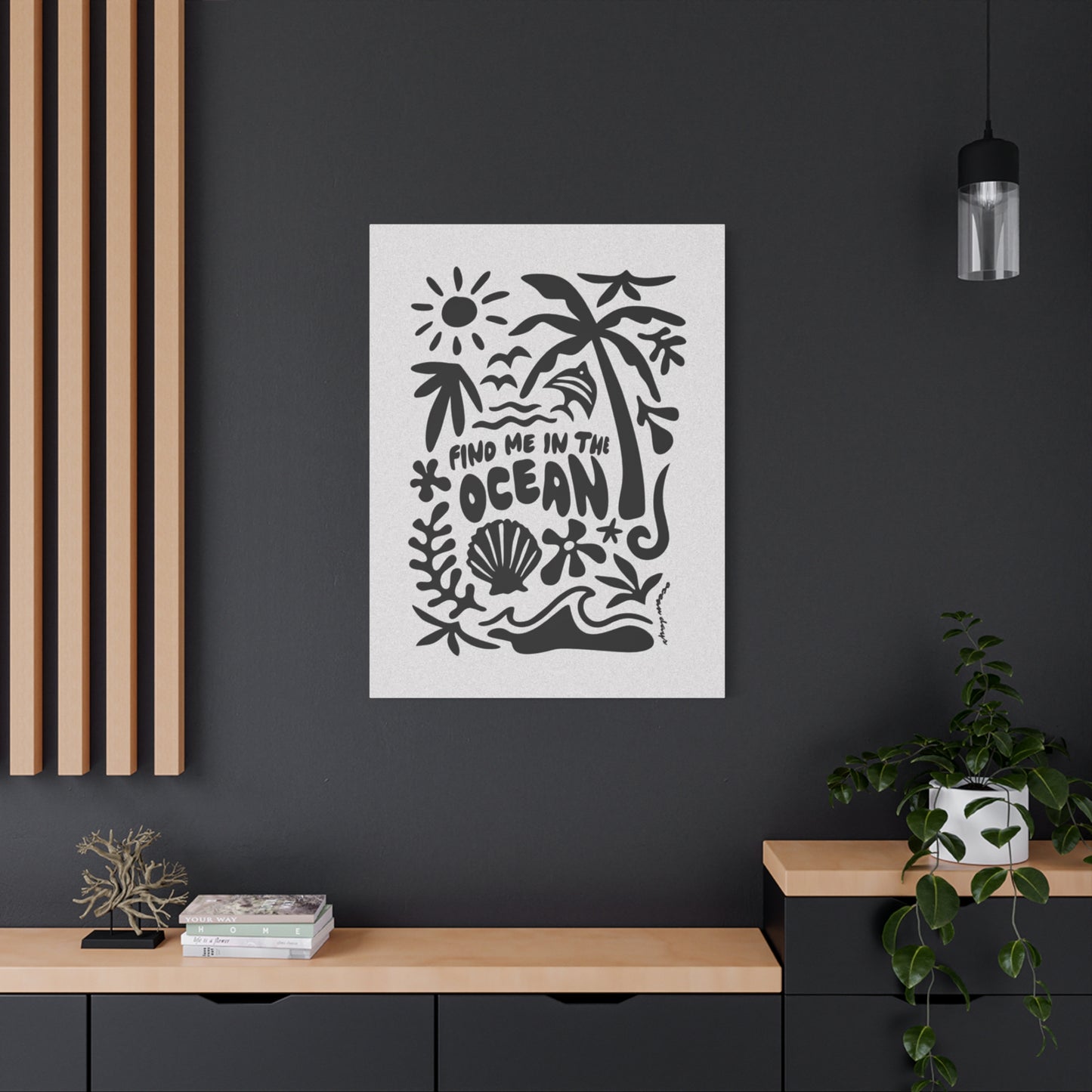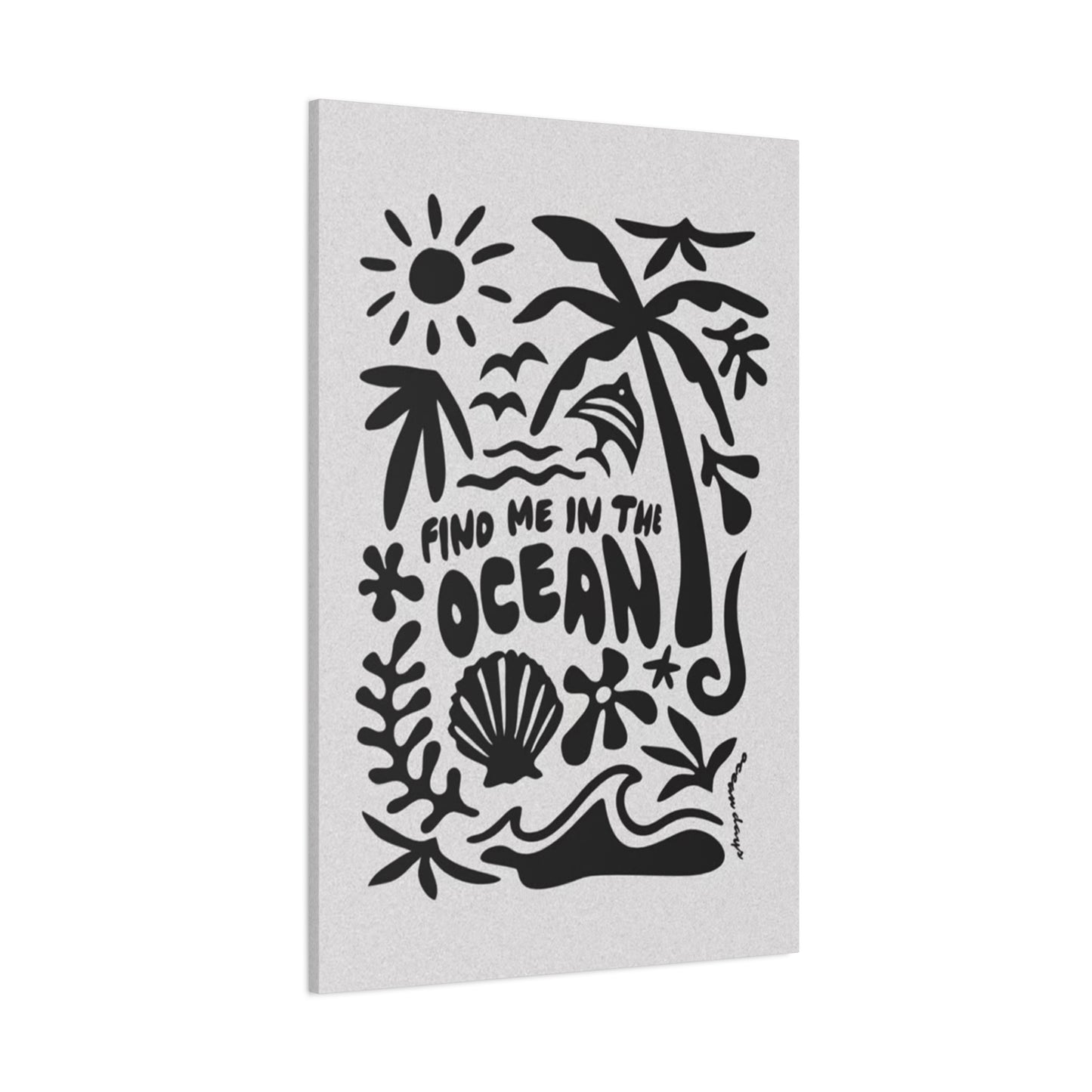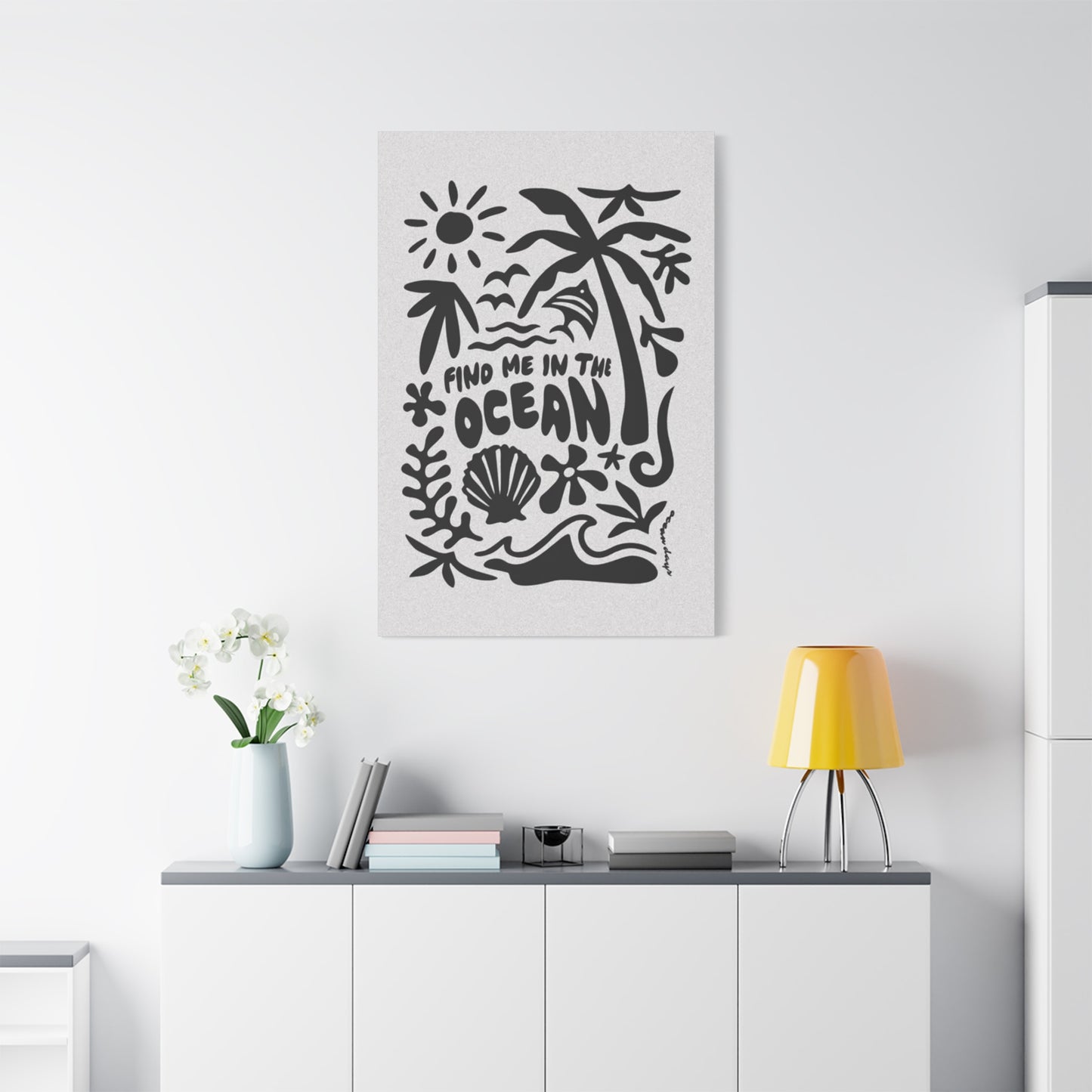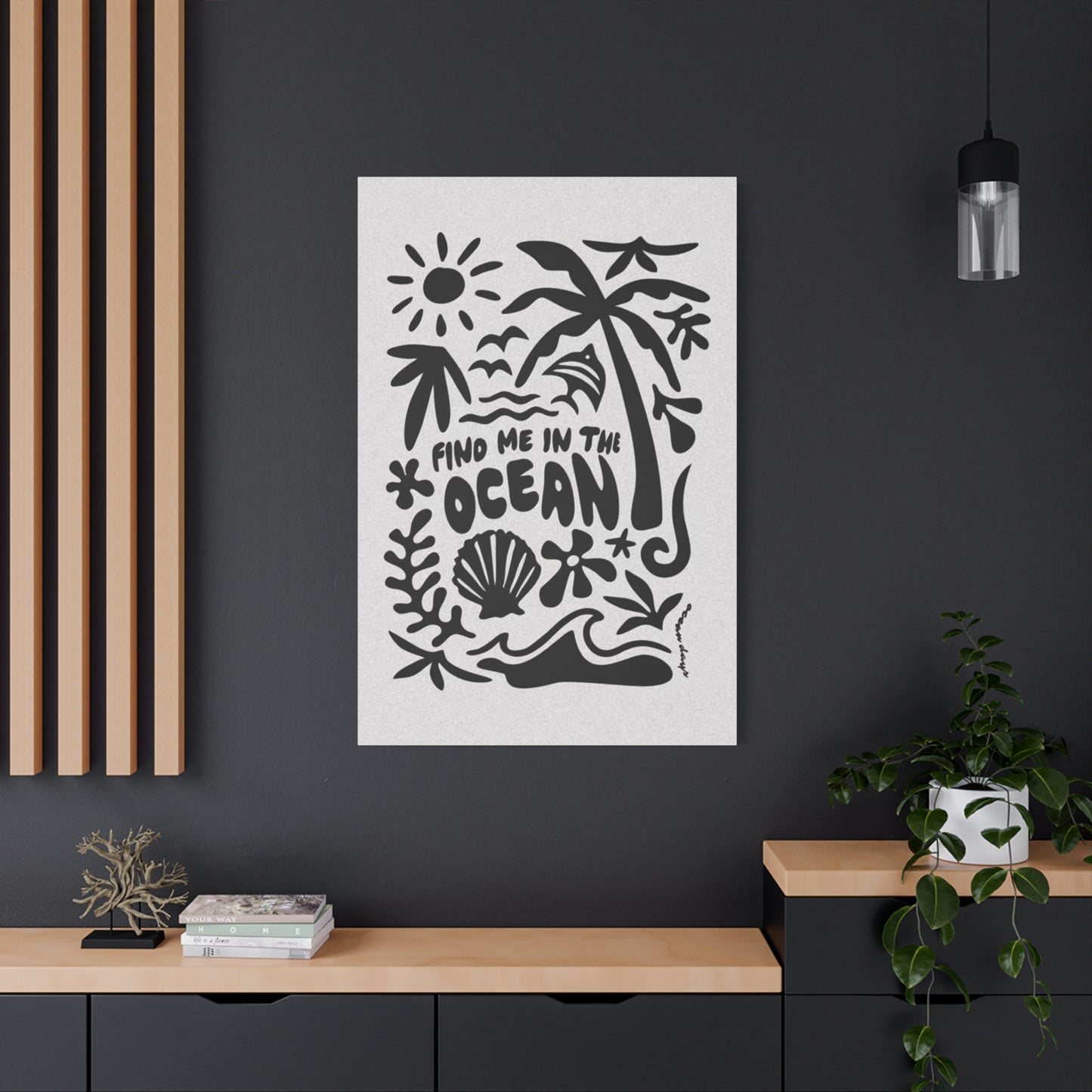Ocean Wall Art: Creating Serene Coastal Sanctuaries Maritime Décor
The profound connection between humanity and the vast expanse of oceanic waters has inspired countless artistic expressions throughout history. Among these creative manifestations, "Find Me in the Ocean" wall art represents a powerful fusion of visual aesthetics and emotional resonance that speaks to our deepest yearnings for tranquility and connection with nature. This maritime-inspired artwork transcends mere decoration, becoming a gateway to serenity and contemplation within our living environments.
The appeal of ocean-themed artwork lies in its ability to transport viewers to peaceful coastal landscapes, even when displayed in urban settings far from any shoreline. These artistic pieces capture the essence of marine environments through carefully curated visual elements that evoke feelings of calm, freedom, and endless possibility. The phrase "Find Me in the Ocean" particularly resonates with individuals seeking escape from daily stresses and a return to natural harmony.
Contemporary homeowners increasingly recognize the therapeutic benefits of incorporating water-themed artwork into their living environments. Research in environmental psychology demonstrates that exposure to blue hues and aquatic imagery can significantly reduce stress levels and promote mental well-being. This understanding has driven the growing popularity of ocean-inspired wall art as both an aesthetic choice and a wellness strategy.
The versatility of "Find Me in the Ocean" artwork makes it suitable for various architectural styles and room configurations. Whether displayed in minimalist modern homes or traditional coastal cottages, these pieces adapt seamlessly to their surroundings while maintaining their distinctive character. The key lies in understanding how different design elements work together to create cohesive visual narratives that enhance rather than overwhelm existing décor schemes.
Discovering the Beauty of "Find Me in the Ocean" Wall Art
The artistic movement surrounding "Find Me in the Ocean" wall art encompasses diverse creative approaches that celebrate maritime beauty through multiple mediums and techniques. Artists working within this genre draw inspiration from various oceanic elements, including crashing waves, serene seascapes, marine wildlife, and the interplay between water and light. These visual components combine to create artworks that serve as windows into aquatic worlds.
Typography plays a crucial role in many "Find Me in the Ocean" pieces, with carefully selected fonts and lettering styles that complement the overall aesthetic message. The relationship between textual elements and imagery requires delicate balance to ensure neither component overshadows the other. Successful pieces achieve harmony between written words and visual representations, creating unified artistic statements that speak to both intellectual and emotional responses.
Color theory becomes particularly important when examining ocean-themed artwork, as the selection and application of hues directly influence viewer perception and emotional response. Traditional oceanic color palettes often feature various shades of blue, from deep navy to soft aqua, complemented by sandy beiges, pearl whites, and occasional accent colors that reflect marine life or coastal vegetation. However, contemporary artists often experiment with unexpected color combinations that challenge conventional assumptions while maintaining connection to aquatic themes.
The textural quality of "Find Me in the Ocean" artwork adds another dimension to its appeal. Many pieces incorporate techniques that simulate the movement and fluidity of water through brushwork, digital manipulation, or mixed media applications. These textural elements create visual interest and depth that draw viewers into contemplative engagement with the artwork.
Compositional strategies in ocean-themed wall art often employ principles derived from landscape painting traditions, including the rule of thirds, leading lines, and focal point emphasis. Artists may position horizons at strategic points within their compositions to create sense of expansiveness and freedom that mirrors the infinite nature of oceanic vistas. The arrangement of elements within the frame contributes to the overall emotional impact of the piece.
The cultural significance of ocean imagery extends beyond aesthetic considerations to encompass symbolic meanings that have developed across different societies and historical periods. Water has long represented purification, renewal, and transformation in various cultural contexts. These symbolic associations add layers of meaning to "Find Me in the Ocean" artwork that resonate with viewers on subconscious levels.
Creating Peaceful Environments with "Find Me in the Ocean" Art
The strategic placement of "Find Me in the Ocean" artwork within living environments requires careful consideration of multiple factors that influence both visual impact and psychological effect. The size and scale of artwork relative to wall dimensions and surrounding furnishings determine whether pieces will serve as focal points or complementary accents within overall design schemes. Proper scaling ensures that artwork enhances rather than overwhelms room aesthetics.
Lighting conditions significantly affect how ocean-themed artwork appears and functions within different environments throughout various times of day. Natural light sources can enhance the luminous qualities of water-themed pieces, while artificial lighting systems may require adjustment to prevent glare or color distortion. The relationship between artwork and light sources should be evaluated during different lighting conditions to ensure optimal presentation.
The psychological effects of ocean imagery extend beyond immediate visual pleasure to encompass longer-term benefits for mental health and emotional well-being. Studies in therapeutic environments have demonstrated that exposure to nature-based artwork, particularly aquatic scenes, can reduce anxiety levels and promote relaxation responses. These findings support the growing trend toward incorporating "Find Me in the Ocean" pieces in healthcare facilities, meditation centers, and wellness-focused residential areas.
Room function and intended use patterns should influence decisions about where and how to display ocean-themed artwork. Bedrooms may benefit from gentler, more subdued oceanic imagery that promotes restful sleep, while living areas might accommodate more dynamic or vibrant pieces that energize social interactions. The alignment between artwork characteristics and room purposes enhances the overall effectiveness of design choices.
Acoustic considerations also play a role in creating calm environments enhanced by ocean artwork. The visual suggestion of water movement and marine environments can be psychologically reinforced through complementary audio elements, such as gentle wave sounds or ambient aquatic recordings. This multi-sensory approach deepens the immersive experience that "Find Me in the Ocean" artwork can provide.
The maintenance and preservation of ocean-themed artwork requires attention to environmental factors that might affect longevity and appearance. Humidity levels, temperature fluctuations, and exposure to direct sunlight can all impact various types of artistic media. Proper care ensures that these meaningful pieces continue to provide aesthetic and emotional benefits over extended periods.
Climate considerations become particularly relevant when displaying ocean artwork in coastal locations where actual marine environments might influence indoor conditions. Salt air, increased humidity, and temperature variations associated with proximity to large bodies of water require appropriate protective measures and frame selection to prevent deterioration.
Exploring Various Styles for "Find Me in the Ocean" Wall Art Designs
The artistic landscape surrounding "Find Me in the Ocean" wall art encompasses an impressive range of stylistic approaches that cater to diverse aesthetic preferences and environmental requirements. Photorealistic representations capture the precise details of oceanic scenes with technical precision that can transport viewers directly to specific coastal locations. These highly detailed works often feature dramatic wave formations, pristine beaches, or underwater marine life rendered with documentary-like accuracy.
Abstract interpretations of ocean themes offer alternative approaches that prioritize emotional expression over literal representation. These pieces may employ fluid brushstrokes, color washes, or geometric patterns that suggest aquatic movement without depicting specific marine elements. Abstract ocean art allows viewers to project their own experiences and associations onto the artwork, creating personalized connections that evolve over time.
Minimalist approaches to "Find Me in the Ocean" artwork emphasize simplicity and restraint while maintaining powerful emotional impact. These pieces often feature clean lines, limited color palettes, and carefully balanced compositions that create sense of serenity and contemplation. Minimalist ocean art works particularly well in contemporary architectural settings where visual clutter might detract from the overall aesthetic message.
Mixed media techniques combine various artistic materials and methods to create layered, textural works that engage multiple senses. Artists working in this style might incorporate actual sand, shells, or driftwood into their pieces, creating physical connections to marine environments. These tactile elements add dimensional quality that enhances the immersive experience of ocean-themed artwork.
Digital art representations of "Find Me in the Ocean" themes utilize contemporary technology to create sophisticated visual effects that would be impossible through traditional media alone. Digital techniques allow artists to manipulate color, texture, and composition with unprecedented precision while incorporating photographic elements, typography, and graphic design principles into cohesive artistic statements.
Vintage and retro styling approaches to ocean artwork draw inspiration from historical artistic movements and design aesthetics. These pieces might incorporate elements reminiscent of mid-century travel posters, Victorian maritime illustrations, or Art Deco graphic design. Vintage-inspired ocean art adds nostalgic character to contemporary settings while maintaining connection to timeless oceanic themes.
Typography-focused designs emphasize the textual component of "Find Me in the Ocean" messaging through creative lettering, calligraphy, or graphic design approaches. These pieces treat words as primary visual elements, using font selection, arrangement, and treatment to convey meaning beyond the literal message content. Typographic ocean art often works well as accent pieces within larger gallery wall arrangements.
Watercolor techniques naturally complement ocean themes through their fluid, translucent qualities that mirror the characteristics of water itself. Watercolor ocean art often features soft edges, color bleeding, and luminous transparency that creates ethereal, dreamlike qualities. These pieces work particularly well in settings where gentle, soothing aesthetics are desired.
Incorporating Ocean Themes with "Find Me in the Ocean" Quotes
The integration of inspirational quotations within ocean-themed artwork creates powerful synergy between visual and textual elements that enhances the overall impact of artistic pieces. "Find Me in the Ocean" serves as a foundational phrase that can be expanded upon or complemented by additional maritime-inspired quotations that deepen the emotional resonance of artwork. The careful selection and placement of textual elements requires consideration of both aesthetic and semantic relationships.
Calligraphy and hand-lettering techniques add personal, artisanal qualities to quote-based ocean artwork that distinguish these pieces from mass-produced alternatives. The flowing, organic characteristics of handwritten text naturally complement the fluid nature of oceanic imagery, creating visual harmony between different artistic elements. Skilled calligraphers can adapt their lettering styles to match the overall mood and aesthetic direction of specific pieces.
The philosophical dimensions of ocean-related quotations extend beyond simple inspirational messaging to encompass deeper themes related to personal growth, spiritual development, and connection with natural world. "Find Me in the Ocean" can be interpreted as an invitation to self-discovery, a call for environmental awareness, or an expression of longing for freedom and adventure. These multiple interpretative layers add richness to artwork that encourages ongoing contemplation.
Color coordination between textual and visual elements requires careful attention to ensure readability while maintaining aesthetic cohesion. Contrast levels must be sufficient to allow easy reading without creating jarring visual disruptions that detract from overall artistic harmony. The strategic use of complementary or analogous color relationships can enhance the integration of quotes within oceanic imagery.
Font selection significantly influences how textual messages are perceived and interpreted within ocean-themed artwork. Serif fonts might convey traditional, established feelings, while sans-serif options suggest modernity and simplicity. Script fonts can add elegance and fluidity, while display fonts might provide dramatic emphasis. The alignment between font characteristics and intended messaging ensures that typography supports rather than conflicts with artistic goals.
Placement strategies for quotes within ocean artwork compositions require consideration of visual weight, reading patterns, and overall compositional balance. Text positioned along natural sight lines guides viewer attention while maintaining integration with background imagery. The size and prominence of textual elements should reflect their relative importance within the overall artistic message.
Cultural sensitivity becomes important when selecting quotes that will be displayed in diverse environments or viewed by audiences from various backgrounds. Universal themes related to nature, peace, and personal reflection tend to resonate broadly, while more specific cultural or religious references might require careful consideration of context and audience. The goal is to create inclusive artwork that speaks to shared human experiences.
Seasonal and temporal considerations can influence how ocean quotes are interpreted and appreciated over time. Messages about renewal and transformation might feel particularly relevant during spring months, while themes of reflection and contemplation could resonate more strongly during winter periods. This temporal dimension adds dynamic quality to artwork that continues to provide fresh insights throughout different life phases.
DIY Ideas for Creating Your Own "Find Me in the Ocean" Wall Art
The creation of personalized "Find Me in the Ocean" artwork offers opportunities for individual expression while developing artistic skills and creating meaningful decorative elements for living environments. Hand-painted canvases provide traditional artistic foundations that can be customized to match specific color schemes, size requirements, and aesthetic preferences. Basic painting techniques, including color mixing, brushwork, and composition principles, can be learned through online tutorials or local art classes.
Digital design approaches make ocean-themed artwork creation accessible to individuals without traditional artistic training. Software applications ranging from simple mobile apps to professional design programs enable users to combine photographic elements, typography, and graphic design components into polished final products. Digital techniques also allow for easy experimentation with different color schemes and layouts before committing to final versions.
Mixed media collage techniques incorporate various materials and textures to create dimensional ocean artwork that engages multiple senses. Collected beach materials such as sand, shells, sea glass, or driftwood can be integrated into artistic compositions alongside painted or printed elements. These tactile additions create personal connections to actual marine environments while adding unique textural interest.
Photography-based approaches involve capturing original oceanic imagery that can be enhanced through editing software and combined with typographic elements to create personalized wall art. This method allows for documentation of meaningful coastal experiences while developing photographic skills and artistic vision. High-quality printing options ensure that digital creations translate effectively into physical artwork suitable for framing and display.
Printable designs offer economical alternatives that can be customized and produced at home using standard printing equipment. Online platforms provide downloadable templates that can be modified with personal touches before printing on various paper types or specialty media. This approach provides professional-looking results without requiring extensive artistic skills or expensive materials.
Embroidery and textile techniques translate ocean themes into fabric-based artwork that adds textural variety to wall displays. Cross-stitch patterns, crewel embroidery, or contemporary thread painting can create unique pieces that incorporate "Find Me in the Ocean" messaging alongside visual ocean elements. These handcrafted pieces carry special significance as expressions of time and skill investment.
Stenciling and template methods enable consistent reproduction of design elements across multiple pieces or different sizes. Custom stencils can be created for specific quotations or graphic elements that are then applied using various painting techniques. This approach works well for creating coordinated series of artworks or adapting designs to different surface materials and sizes.
Upcycling and repurposing projects transform existing materials into ocean-themed artwork while promoting environmental consciousness. Old frames, wooden boards, or fabric pieces can be refreshed with oceanic designs and "Find Me in the Ocean" messaging. These projects combine creative expression with sustainable practices that align with environmental values often associated with ocean appreciation.
The Best Color Palettes for Ocean-Inspired Wall Art
Color selection forms the foundation of effective ocean-inspired artwork, with strategic palette choices directly influencing emotional response and aesthetic integration within living environments. Traditional oceanic color schemes draw inspiration from natural marine environments, incorporating the full spectrum of blue hues from deep navy depths to crystal-clear shallow water tones. These blue variations serve as primary colors that establish the aquatic foundation for artistic compositions.
Complementary color relationships enhance the visual impact of ocean-themed artwork through strategic contrast that creates dynamic tension and visual interest. Orange and coral tones serve as natural complements to blue oceanic hues, reflecting the warm colors often found in sunrise and sunset coastal scenes. These warm accents can be incorporated through small design elements or subtle color variations that add depth without overwhelming the primary aquatic theme.
Monochromatic approaches utilize various shades, tints, and tones within single color families to create sophisticated, harmonious compositions that emphasize texture and form over color contrast. Blue monochromatic schemes can range from pale powder blue to deep midnight navy, creating subtle gradations that mirror the natural depth variations found in actual ocean waters. This approach works particularly well in minimalist or contemporary design environments.
Analogous color combinations incorporate colors that are adjacent to each other on the color wheel, creating gentle transitions and natural harmony within artistic compositions. Blue-green and blue-violet combinations reflect the natural color variations found in different oceanic conditions, from tropical turquoise waters to tempestuous gray-blue storm seas. These analogous relationships create cohesive color stories that feel natural and pleasing to the eye.
Neutral foundations provide stable backdrops that allow oceanic colors to shine while ensuring long-term compatibility with changing décor trends. Sandy beiges, driftwood grays, and pearl whites reflect natural coastal elements that complement rather than compete with blue oceanic hues. These neutral tones can be incorporated as background colors or accent elements that ground more vibrant aquatic colors.
Seasonal color adaptations allow ocean-themed artwork to feel fresh and relevant throughout different times of year. Summer palettes might emphasize bright turquoise and coral combinations that reflect warm weather coastal experiences, while winter adaptations could incorporate cooler grays and deeper blues that suggest stormy seas and contemplative moods. This seasonal flexibility extends the long-term appeal of ocean artwork.
Lighting considerations significantly affect how colors appear in different environments and at various times of day. Natural daylight reveals the true characteristics of oceanic colors, while artificial lighting might shift color perception in subtle ways. Warm artificial light can enhance the golden undertones in sandy beiges and coral accents, while cool lighting might emphasize the clarity of blue oceanic hues.
Cultural color associations can influence how oceanic palettes are perceived and interpreted within different social contexts. While blue universally suggests water and tranquility, specific cultural meanings might affect how certain color combinations are received. Understanding these associations helps ensure that artwork resonates positively with intended audiences and environments.
Personal color preferences should ultimately guide selection decisions, as artwork that personally resonates will provide greater long-term satisfaction and emotional benefit. Individual responses to color are influenced by personal experiences, cultural background, and psychological factors that vary among different viewers. The most successful ocean-themed artwork often reflects the personal aesthetic preferences of those who will live with and appreciate it daily.
How "Find Me in the Ocean" Art Inspires Relaxation and Mindfulness
The therapeutic potential of "Find Me in the Ocean" artwork extends far beyond aesthetic appreciation to encompass measurable benefits for mental health and emotional well-being. Scientific research in the fields of environmental psychology and neuroaesthetics has demonstrated that exposure to water-themed imagery can trigger physiological responses associated with relaxation, including reduced heart rate, lowered blood pressure, and decreased cortisol levels. These biological markers indicate that ocean artwork can serve as effective tools for stress management and emotional regulation.
The concept of biophilia suggests that humans possess an innate affinity for natural environments, including marine ecosystems, that has evolved over millions of years. This psychological predisposition helps explain why ocean imagery consistently produces positive emotional responses across diverse populations and cultural backgrounds. "Find Me in the Ocean" artwork taps into these deep-seated connections, creating immediate sense of comfort and familiarity that supports relaxation responses.
Mindfulness practices often incorporate visual focal points that help practitioners maintain present-moment awareness while reducing mental chatter and anxiety. Ocean-themed artwork provides ideal subjects for mindful observation, with flowing forms, gentle color transitions, and symbolic depth that reward sustained attention. The phrase "Find Me in the Ocean" can serve as a meditation prompt that encourages introspective exploration and self-discovery.
Color psychology principles explain how specific hues associated with oceanic environments affect mood and mental state. Blue tones have been consistently linked to feelings of calm, trust, and stability, while the dynamic interplay of light and shadow in ocean imagery stimulates visual interest without creating overwhelming stimulation. These color effects work subconsciously to create environments that naturally support relaxation and contemplation.
The symbolic associations connected to oceanic imagery provide rich material for psychological processing and emotional healing. Water represents cleansing, renewal, and transformation across many cultural and spiritual traditions. The vast expanse of the ocean suggests infinite possibility and freedom from earthly constraints. These metaphorical dimensions add depth to "Find Me in the Ocean" artwork that supports therapeutic applications and personal growth.
Breathing techniques used in meditation and stress reduction can be enhanced through synchronization with visual representations of ocean rhythm and movement. The natural ebb and flow of waves provide visual metaphors for healthy breathing patterns, while the repetitive nature of oceanic movement creates hypnotic effects that can induce meditative states. This synchronization between visual imagery and physiological processes amplifies the relaxation benefits of both practices.
Environmental design principles recognize that carefully curated visual environments can significantly impact occupant well-being and productivity. Healthcare facilities, therapeutic offices, and wellness centers increasingly incorporate ocean-themed artwork to create healing environments that support patient recovery and emotional processing. The non-threatening, universally appealing nature of oceanic imagery makes it suitable for diverse therapeutic applications.
Sleep quality can be improved through bedroom environments that incorporate calming ocean artwork and color schemes. The association between oceanic imagery and relaxation helps prepare the mind for rest, while cool blue tones naturally support the physiological processes involved in healthy sleep cycles. "Find Me in the Ocean" pieces displayed in sleeping areas can serve as final focal points before sleep and first impressions upon waking, bookending daily rest periods with peaceful imagery.
Using "Find Me in the Ocean" Wall Art in Beach House Decor
Coastal residential environments provide natural settings where "Find Me in the Ocean" artwork can reach its full decorative and emotional potential. Beach house décor strategies should consider the relationship between indoor artwork and the actual marine environment visible through windows and doors. The goal is to create seamless transitions between interior and exterior oceanic experiences while avoiding redundancy or visual competition between natural and artistic elements.
Architectural considerations unique to coastal construction influence how ocean-themed artwork functions within beach house environments. High ceilings common in coastal architecture provide opportunities for larger-scale artwork that might overwhelm standard residential rooms. Open floor plans typical of beach house design require careful attention to sight lines and visual flow to ensure that artwork enhances rather than interrupts architectural features.
Material selection for coastal artwork must account for environmental factors including salt air, humidity, and temperature fluctuations that characterize seaside locations. Frames, mounting hardware, and protective glazing should be chosen for their ability to withstand these challenging conditions while maintaining appearance and structural integrity over time. Proper material selection ensures that meaningful artwork continues to provide enjoyment throughout extended coastal exposures.
Seasonal occupancy patterns common to many beach houses influence artwork selection and display strategies. Pieces that will be viewed primarily during summer months might emphasize brighter, more energetic oceanic themes, while year-round residences might benefit from artwork that remains appealing during stormy winter seasons. The temporal dimension of beach house occupation should be considered when planning artwork installations.
Natural light management becomes particularly important in coastal settings where large windows and open exposures create dramatic lighting changes throughout the day. Ocean artwork should be positioned to take advantage of beneficial natural lighting while avoiding harmful direct sunlight that might cause fading or deterioration. The interplay between artwork and changing natural light can create dynamic visual experiences that evolve throughout daily cycles.
Scale and proportion relationships between artwork and architectural features require careful consideration in beach house environments where room sizes and ceiling heights often exceed standard residential dimensions. Artwork that appears appropriately sized in conventional homes might appear diminished in grand coastal settings, while pieces scaled for beach houses might overwhelm more modest environments.
Privacy and security considerations affect artwork selection for vacation properties that may remain unoccupied for extended periods. Valuable or irreplaceable pieces might require special protection or seasonal removal, while more affordable options might be selected specifically for their replaceable nature. These practical considerations influence both artistic choices and display methods.
Integration with existing coastal collections should be considered when beach houses already contain nautical artifacts, marine specimens, or other ocean-related decorative elements. "Find Me in the Ocean" artwork should complement rather than compete with these existing collections while adding literary and inspirational dimensions that enhance the overall coastal aesthetic narrative.
Combining Photography and Quotes in Ocean Wall Art
The fusion of photographic imagery with inspirational quotations represents one of the most popular approaches to contemporary "Find Me in the Ocean" wall art creation. This hybrid artistic method combines the documentary power of photography with the emotional resonance of carefully selected words, creating multi-layered pieces that function simultaneously as visual art and inspirational messaging. The success of these combinations depends on achieving balance between photographic and typographic elements that allows each component to enhance rather than overwhelm the other.
Technical considerations for photographic elements include image resolution, color accuracy, and compositional strength that will translate effectively to printed formats. High-resolution images ensure that fine details remain sharp and clear when reproduced at various sizes, while proper color management maintains the emotional impact of oceanic hues throughout the printing process. Compositional elements should leave appropriate negative areas where textual elements can be integrated without disrupting the photographic narrative.
Typography selection for photographic combinations requires careful attention to legibility against varying background textures and colors present in oceanic imagery. Font weights, sizes, and colors must be adjusted to ensure readability while maintaining aesthetic harmony with photographic elements. Drop shadows, outlines, or semi-transparent background panels might be employed to improve text legibility without completely obscuring underlying photographic detail.
Layering techniques allow for sophisticated integration of photographic and typographic elements through digital compositing methods that create depth and visual hierarchy. Text elements might be positioned to appear as part of the photographic scene, floating above the image, or integrated into natural elements like sand, sky, or water surfaces. These layering approaches create immersive experiences that blur the boundaries between photography and graphic design.
Message alignment between photographic subjects and textual content ensures that both elements work together to convey unified artistic statements. Dramatic storm scenes might be paired with quotes about overcoming challenges, while serene sunset images could be combined with messages about peace and reflection. This thematic coordination amplifies the emotional impact of both photographic and textual components.
Size and scale relationships between photographs and text must be carefully calibrated to create appropriate visual hierarchy that guides viewer attention through intended narrative sequences. Large, bold typography might compete with detailed photographic elements, while text that is too small might be lost against complex oceanic backgrounds. Testing different size relationships helps identify optimal proportions for specific combinations.
Color coordination strategies ensure that textual elements complement rather than clash with photographic color palettes. Text colors might be selected to match specific hues present in the photograph, or neutral colors might be chosen to avoid color conflicts. The goal is to create cohesive color stories that feel natural and intentional rather than forced or accidental.
Print quality considerations become particularly important when reproducing photographic elements that depend on subtle tonal gradations and color accuracy for their impact. Professional printing services and high-quality papers can preserve the full dynamic range and color gamut of oceanic photography while ensuring that textual elements maintain sharp edges and consistent color. Investment in quality reproduction ensures that the final artwork matches the creator's artistic vision.
Why Ocean-Themed Art is Perfect for Meditation Rooms
Meditation environments require carefully curated visual elements that support rather than distract from contemplative practices, making ocean-themed artwork particularly well-suited for these specialized applications. The natural association between water imagery and mental tranquility creates immediate psychological preparation for meditative states, while the symbolic depth of oceanic themes provides rich material for contemplative exploration. "Find Me in the Ocean" artwork can serve as both focal points for concentration practices and inspirational reminders of meditation intentions.
Visual simplicity becomes crucial in meditation room applications where complex or stimulating imagery might interfere with the mental quieting process. Ocean artwork designed for meditative environments should emphasize gentle transitions, harmonious color relationships, and uncluttered compositions that promote rather than hinder psychological settling. The phrase "Find Me in the Ocean" can serve as a meditation instruction that encourages practitioners to dive deeply into present-moment awareness.
Symbolic resonance between oceanic imagery and meditative concepts provides natural connections that support contemplative practices. The vast expanse of the ocean mirrors the infinite nature of consciousness explored in many meditation traditions, while the rhythmic movement of waves reflects the cyclical nature of breath and thought. These symbolic parallels create environments where visual and psychological elements work together to support meditative exploration.
Color temperature considerations affect how ocean artwork functions within meditation environments throughout different times of day and seasons. Cool blue tones naturally promote relaxation and introspection, while warmer accent colors might provide gentle energy that supports alertness during meditation. The balance between calming and energizing visual elements should reflect the specific types of meditation practices that will occur in the room.
Size and positioning strategies for meditation room artwork should consider the relationship between visual elements and seating arrangements used for practice. Artwork positioned at eye level for seated practitioners provides natural focal points, while pieces placed slightly above eye level encourage gentle upward gaze that can support certain meditation techniques. The goal is to create visual support that enhances rather than competes with meditative focus.
Lighting design integration ensures that ocean artwork remains visible and effective under the varied lighting conditions often used in meditation environments. Dimmer controls allow for adjustment of ambient lighting levels that complement different meditation practices, while indirect lighting techniques prevent glare that might distract from visual meditation objects. The interplay between artwork and lighting creates atmospheric conditions that support contemplative states.
Acoustic considerations recognize that meditation environments often incorporate sound elements that should harmonize with visual components. Ocean artwork creates natural associations with wave sounds, flowing water, or ambient marine audio that can enhance multi-sensory meditation experiences. The visual suggestion of oceanic movement provides psychological preparation for audio elements that might be introduced during practice sessions.
Maintenance and care requirements for meditation room artwork should be minimal to avoid creating distractions or disruptions to regular practice schedules. Simple cleaning procedures and durable materials ensure that artwork continues to provide aesthetic and psychological support without requiring frequent attention or maintenance activities that might interfere with the peaceful atmosphere of meditation environments.
Framing Tips for Your "Find Me in the Ocean" Artwork
Professional framing significantly impacts both the aesthetic presentation and long-term preservation of "Find Me in the Ocean" artwork, making frame selection and preparation crucial considerations for anyone serious about displaying oceanic-themed pieces effectively. The relationship between artwork and frame should enhance rather than compete with the artistic message while providing appropriate protection against environmental factors that might threaten the integrity of the piece over time.
Frame material selection influences both the visual impact and practical performance of artwork presentation. Natural wood frames can complement the organic themes present in ocean artwork while providing warm contrast to cool blue oceanic hues. Metal frames offer contemporary alternatives that work particularly well with photographic or digital ocean pieces, while composite materials provide budget-friendly options that can mimic more expensive natural materials.
Color coordination between frame and artwork requires careful consideration of how frame hues will interact with oceanic color palettes over extended viewing periods. Neutral frame colors typically provide safe choices that won't compete with artwork colors, while carefully selected colored frames might enhance specific elements within the piece. The goal is to create harmonious relationships that feel intentional and sophisticated rather than accidental or conflicting.
Matting considerations can dramatically affect how ocean artwork appears and functions within frame assemblies. White or cream mats provide classic, clean presentations that work well with most oceanic color schemes, while colored mats might be selected to echo specific hues present in the artwork. Mat width should be proportional to both artwork size and frame dimensions to create balanced visual relationships.
Glass and glazing options affect both the appearance and protection level provided by framing systems. Standard glass provides basic protection while maintaining cost effectiveness, while museum-quality glazing offers superior protection against ultraviolet light, reflection, and environmental contaminants. The choice between glazing options should reflect the value and intended longevity of the artwork being protected.
Mounting techniques ensure that artwork remains properly positioned within frames while allowing for natural expansion and contraction that occurs with environmental changes. Acid-free materials prevent chemical reactions that might cause discoloration or deterioration over time, while proper mounting techniques avoid damage that might result from improper attachment methods. Professional mounting ensures that valuable pieces receive appropriate preservation treatment.
Size and proportion relationships between artwork, matting, and frame dimensions require careful calculation to achieve pleasing visual results. Frame width should be appropriate for artwork size without overwhelming smaller pieces or appearing inadequate for larger works. The mathematical relationships between these elements follow established design principles that create harmonious presentations.
Hanging hardware selection and installation affect both the security and presentation of framed ocean artwork. Wall anchors must be appropriate for both wall construction and artwork weight, while hanging systems should allow for easy adjustment and leveling. Proper installation ensures that artwork remains securely positioned while allowing for minor adjustments that might be needed over time.
Environmental protection considerations become particularly important for valuable or irreplaceable ocean artwork that represents significant financial or emotional investment. Proper framing can provide barriers against dust, moisture, insects, and other environmental threats that might compromise artwork integrity. These protective measures ensure that meaningful pieces continue to provide enjoyment for extended periods.
How to Mix "Find Me in the Ocean" Art with Other Nautical Decor
The integration of "Find Me in the Ocean" artwork within broader nautical decorative schemes requires careful attention to thematic coherence and visual balance that allows different oceanic elements to work together harmoniously rather than competing for attention. Successful combinations create layered narratives that celebrate maritime culture through multiple artistic mediums while maintaining sophisticated aesthetic standards that avoid clichéd or overly literal interpretations of nautical themes.
Scale relationships between artwork and three-dimensional nautical objects determine how different elements will interact visually within shared environments. Large "Find Me in the Ocean" pieces might serve as anchoring elements that provide backdrops for smaller nautical artifacts, while medium-sized artwork might be grouped with complementary objects to create balanced vignettes. The goal is to achieve visual hierarchy that guides viewer attention through intentional sequences rather than random arrangements.
Color coordination strategies ensure that oceanic artwork integrates smoothly with existing nautical color schemes that might include traditional navy blues, crisp whites, and weathered wood tones. "Find Me in the Ocean" pieces should complement these established palettes while potentially introducing subtle variations or accent colors that add visual interest without disrupting overall harmony. Successful color integration creates cohesive environments that feel intentional and sophisticated.
Texture mixing allows for dynamic interplay between smooth artwork surfaces and varied textural qualities found in nautical artifacts such as rope, weathered wood, metal hardware, and natural materials. These textural contrasts create tactile interest that engages multiple senses while adding dimensional quality to predominantly visual artwork displays. The combination of smooth and rough textures reflects the varied environmental conditions found in actual marine settings.
Spatial arrangement principles guide the positioning of artwork relative to nautical objects to create balanced compositions that feel natural rather than forced. Asymmetrical arrangements often feel more organic and interesting than rigidly symmetrical displays, while groupings of odd numbers typically appear more pleasing than even-numbered arrangements. These compositional guidelines help create displays that feel comfortable and inviting.
Lighting considerations become more complex when illuminating mixed displays that include both reflective and non-reflective surfaces. Artwork glazing might create unwanted reflections that interfere with viewing, while metal nautical objects might produce bright highlights that compete with artwork. Careful lighting placement and selection can minimize these challenges while enhancing the positive qualities of both artwork and objects.
Seasonal rotation strategies allow nautical displays to remain fresh and interesting throughout different times of year. Summer arrangements might emphasize brighter, more energetic oceanic themes, while winter displays could focus on stormier, more contemplative maritime imagery. This temporal flexibility keeps displays feeling current and responsive to changing environmental conditions and personal moods.
Personal narrative development through curated displays that tell stories about individual relationships with oceanic environments adds meaning beyond purely aesthetic considerations. "Find Me in the Ocean" artwork might be combined with personal nautical artifacts, travel souvenirs, or family heirlooms that reflect specific maritime experiences or connections. These personal elements create unique displays that cannot be replicated elsewhere.
Popular Artists Creating Ocean Quote Wall Art
The contemporary art market features numerous talented artists who specialize in creating "Find Me in the Ocean" and similar oceanic quote artwork that combines visual artistry with inspirational messaging. These creators work across various mediums and styles, from traditional watercolor paintings to digital designs, each bringing unique perspectives and technical approaches to the growing field of inspirational ocean art. Understanding different artistic styles and approaches helps collectors and enthusiasts make informed decisions about artwork selection and investment.
Digital artists have emerged as particularly influential creators in the ocean quote art category, utilizing sophisticated software tools to combine photographic elements, custom typography, and graphic design principles into polished final products. These artists often maintain online portfolios and offer print-on-demand services that make their work accessible to broad audiences while maintaining high quality standards. The digital medium allows for easy customization and scaling that serves diverse decorative needs.
Watercolor specialists bring traditional artistic techniques to ocean quote artwork, creating pieces with organic, flowing qualities that naturally complement aquatic themes. The translucent nature of watercolor paint mirrors the luminous qualities of ocean water while allowing for soft color transitions and atmospheric effects that enhance emotional impact. Many watercolor artists offer original works alongside high-quality.
Conclusion
Ocean wall art is a beautiful gateway to creating serene coastal sanctuaries within your home, effortlessly bringing the calming and majestic qualities of the sea indoors. Whether through vibrant seascapes, minimalist wave patterns, or detailed marine life illustrations, ocean-themed artwork evokes a sense of tranquility, freedom, and connection to nature. Incorporating maritime décor with ocean wall art transforms any space into a peaceful retreat, inviting you to relax, rejuvenate, and embrace the soothing rhythms of coastal life.
The appeal of ocean wall art lies not only in its visual beauty but also in the emotions it stirs—calmness, inspiration, and a longing for the vastness of open water. This type of décor complements a wide range of interior styles, from rustic beach houses and nautical-themed rooms to contemporary and minimalist spaces. Its versatile color palettes, often featuring soft blues, sandy neutrals, and crisp whites, harmonize with natural textures like driftwood, linen, and woven fibers to create an authentic maritime ambiance.
From a design perspective, ocean wall art works beautifully as a focal point above a sofa, bed, or mantel, or as part of a curated gallery wall with complementary coastal elements. Thoughtful placement and lighting can enhance the artwork’s depth and serenity, allowing the sea’s ever-changing moods to inspire your daily life. Additionally, pairing ocean art with seashell accents, coral sculptures, or nautical maps deepens the connection to maritime themes and enriches the overall décor.
In conclusion, ocean wall art is a timeless and versatile choice for those looking to cultivate a serene coastal sanctuary at home. It brings natural beauty, peaceful energy, and maritime charm into your living environment, transforming ordinary rooms into inspiring escapes. Whether you seek relaxation, creativity, or a reminder of your love for the sea, ocean-themed art offers a perfect solution to elevate your décor and soothe your spirit.

















